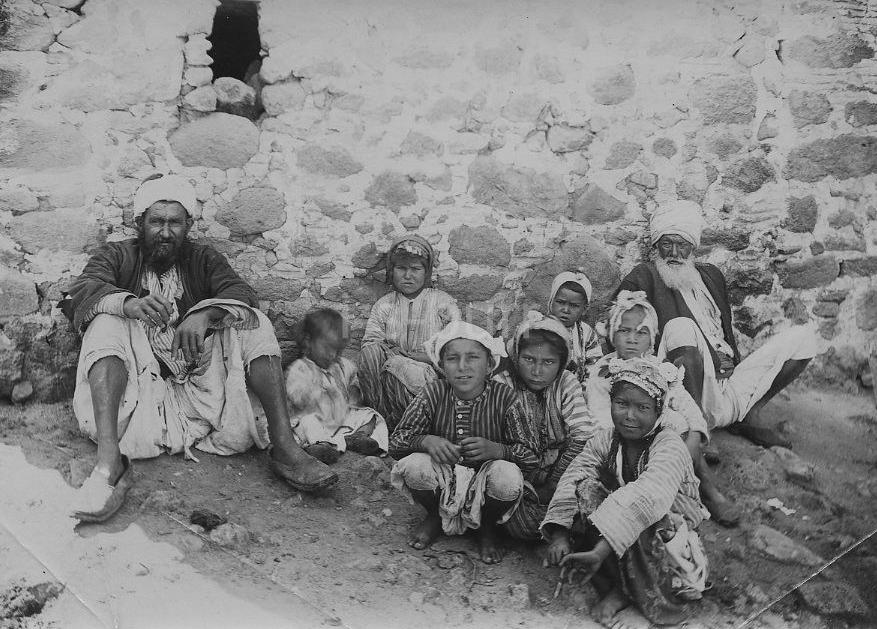
Arab Economic Development: Oil

Figure 1.--It is difficult to underatand how primitive the arabs were before the arrival of the Europeans and then the discovery of oil. This unidentified photograph was taken in the early-1900s. There is no way of telling it was taken in the 20th century. If we had photographs from the 10th century a millenium earlier, it would not have been any different. We know of no society oitside of Africa, except perhaps with the exception of Muslim Central Asia, that remained unchanged for a millenium. This was the society which suddently found incredible wealth with oil dicoveries.
|
|
The Middle East and North Africa other than Africa entered the 20th century as the poorest region in the world. Photographs in the late-19th and early-20th century show a region and society virtually untouched by time and modernuity. I recall a Bible our grandmother bought us about 1950. It included photographs of the region and there was no way of telling that they could not have been taken in Jesus' time. I was so young at the time that I thought they were actual Biblical pictures since they were in the Bible. One has to ask how the region and the Arab people could have defied modernity for such a long period of time. The region entered the 20th century in abject poverty and with a largely uneducated, illerate population. There were few schools and hospitals. Electricity was virtually unknown, except in a few major cities. At about the same time, the industrial world (America and Europe) began a transition from coal to oil. Oil was particularly important for tranportation fuel. Ameica was the first great oil power. And oil not only fueled America's indutrial expansion, but helped win World War II, helping to save Western Civilization. Oil had been found in the Middle East at the time of World War I, but at the time production had only began. After The War as american prodution peaked, Middle Eastern production declined. The Arabs helped organize The Organization of Petroleum Exporting Countries (OPEC). And as American oil production declined, Middle eastern oil production increased. This not only affored great importance to the oil producig countries, but bought great th to the region. Small sheikdoms vurtually unknown, became known to the rest of the world. Theoretically the oil welth could have been used to finance the development of modern counties. This has not occurred. Rather it has been used to but arms and to buy a modern life style, but not to develop a modern economy. In many countries the oil money has been used to prevent moderizaion. Some of the countries look modern with high-rize modernistic building and modern airports, but they do not have modern economies that create and manufacture products. Rather industrial proucts like cars, computers, locomotives, jet aircraft, new pharmaceuticals, ect. are all imported, not produced locally. All paid with by petro-dollars. And as the owr of OPEC increased, oil prices rose from $3 a barel to over $100 barrel. This resulted in the greatest transfer of wealth in hyman history. The countries are governed by a collection of autocrats, theoctats, and dictators. As oil money flowed directly into the treasury, they aew unaccountable to their preople which are then bought off with a share of the oil money. In some of the petro states, the oil has allowed the leaders to maintain medevil systems. The dictators habe had more modern gials, but largely wasted the money on excesses, arms, and wars. The one petro-state that has had some success at modenizing is Iran, thanks primarily to the modenizing efforts of the Shah before he was deposed. The ecomny of the Middle east is today undergoing a major change. American enegy companies have developed new technologies for extracting oil. As a result the income of the Middle eastern [tro-states has been cut by moe than aand it is still not clear where the oil orices will level out. This willmean major changes in the Middke east that can not yet be foreseen.
CIH

Navigate the Children in History Web Site:
[Return to the Middle eastern exonomic development--The Arabs]
[Return to the Main Middle Eastern economic page]
[Return to the Main Middle-East economic development page]
[Return to the Main economics page ]
[About Us]
[Introduction]
[Biographies]
[Chronology]
[Climatology]
[Clothing]
[Disease and Health]
[Economics]
[Freedom]
[Geography]
[History]
[Human Nature]
[Law]
[Nationalism]
[Presidents]
[Religion]
[Royalty]
[Science]
[Social Class]
[Bibliographies]
[Contributions]
[FAQs]
[Glossaries]
[Images]
[Links]
[Registration]
[Tools]
[Children in History Home]
Created: 1:28 AM 2/2/2016
Last updated: 12:41 AM 4/4/2016



